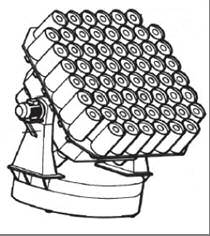Spectroscopic measurements and simultaneous images Current telescope are large apertures, which is achieved with either mirrors which are heavy, complex to handle and expensive to build. The larger the telescope diameter (aperture), the higher the amount of light that can be collected and therefore, the more sensitive the measurements. The present invention instead collects light from many smaller optical tubes, and couples them together, achieving a bigger resolution and depth image. Each mounting with several optical assemblies attached is referred to as a module (Figure I). The components that make up each optical tube are equipped with several optimizable subsystems according to the specific final application. The final effective opening of the device is scalable, using different number of optical assemblies and depending on their diameters. Figure I. Optical assembly module mounted on a bracket
Main innovations and advantages
· The cost and the weight of the mirrors is much smaller than that or those of an equivalent aperture telescope of conventional type.
· The mechanical structures needed and the mounts are also much lighter and smaller in volume · It implies that the telescope enclosures can also be much smaller and much cheaper.
· The total cost and the maintenance and operation costs are lower than in a conventional design.
· The design allows achieving higher dynamic range imaging tan previous realizations and offers a great field of vision · The final opening can be increased by combining several modules.
· Applications possible: in the Astronomy or Astrophysics field. In addition, in the telecommunication field with terrestrial stations or the detection of spatial waste.








